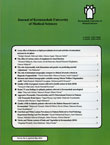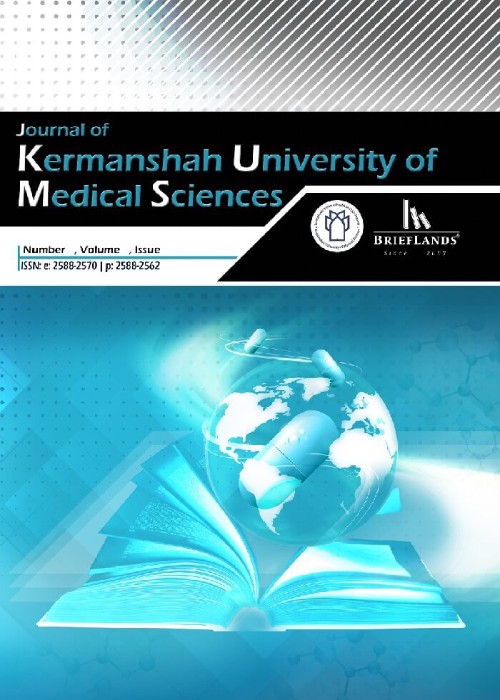فهرست مطالب

Journal of Kermanshah University of Medical Sciences
Volume:20 Issue: 2, 2016
- تاریخ انتشار: 1395/07/12
- تعداد عناوین: 7
-
-
Pages 43-50IntroductionIn recent years, evidence has shown the growing trend of published studies on family-oriented interventions in children with cancer. Besides shedding light on the current status of knowledge, a review of the existing evidence can serve an effective step toward designing and implementing appropriate interventions in this domain.MethodsThis systematic review was carried out to categorize and report the findings of all types of psychosocial interventions on the family caregivers of children with cancer. The English keywords "family career", "family caregiver", children with cancer", "psychosocial", "intervention, educational", and "childhood cancer" were searched in CINAHL, Web of Science (ISI), PsychINFO, Pubmed and Scopus databanks, and equivalent Persian keywords were searched in the SID of Jihad University, IRANDOC, and IranPsych and Magiran databanks. From among 819 papers found between 1994 and 2014, a total of 17 articles were included in the study after qualitative evaluation.ResultsInterventions were often performed on mothers and indicated various interventional approaches. The majority of the interventions were cognitive-behavioral which were reported to be effective in improving the measured criteria such as increasing the quality of life, decreasing emotional distress, anxiety and depression, and increasing adaptive behaviors.ConclusionThe findings were generally reported to be hopeful and most of interventions were reported to have positive effects on the participants, among which behavioral-cognitive interventions were found to show the strongest evidence. Supportive interventions must be considered as an indispensable part of care for children with cancer.Keywords: Intervention, family caregivers, systematic review, children with cancer
-
Pages 51-55IntroductionPost Dural puncture headache is still a common complication among young women undergone cesarean section, although use of small size spinal needles reduced its prevalence. Several methods have been suggested for prevention and treatment of this side effect; such as complete bed rest, hydration, non-opioid analgesics, caffeine, codeine, which none of them proved to be totally effective. The last option would be epidural blood patch, if headache persist. The aim of this study was evaluation the efficacy of intravenous propofol on post dural puncture headache incidence after cesarean section.MethodsIn a randomized clinical trial 120 patients aged 18-45 years old in American Society of Anesthesiologist (ASA) class I or II, who had no history of headache, analgesic consumption, substance abuse and drug addiction, candidate for elective cesarean section, were randomly assigned into intervention (propofol) and control groups. The anesthesia method for both groups was precisely the same. After spinal anesthesia in the first group 30µg/kg/min of intravenous propofol have been infused slowly. Then at 1, 6, 18, 24 hours and 2nd to 7th days after surgery, anesthesiologist asked groups for presence or absence of headache. The data analyzed with SPSS 16.0 software.ResultsHeadache incidence rate in the group who receiving propofol was significantly reduced (P.V=0.001).ConclusionThis study showed that 30µg/kg/min of intravenous propofol caused reduced the incidence of post spinal headache in young women undergone elective cesarean section. Supportive interventions must be considered as an indispensable part of care for children with cancer.Keywords: Propofol, post, dural puncture, headache, spinal anesthesia, cesarean section
-
Pages 56-61IntroductionControlling and reducing serum uric acid levels may have beneficial effects on blood pressure control. The current study was carried out to assess the effects of allopurinol administration on serum uric acid and arterial blood pressure among the patients under hemodialysis.MethodsThis double-blind clinical trial was conducted on 132 hemodialysis patients (two separate groups) suffering from hyperuricemia and hypertension at Imam Reza hospital, Kermanshah in 2014. The first group received a daily dose of 100 mg allopurinol and the second group, as control, received placebo. The demographic data, vital signs, paraclinical data and comorbidities of all patients were recorded in a checklist. Serum uric acid and blood pressure were measured at the end of the first, second and third months. The obtained data were analyzed by SPSS software using t-test, paired t-test and repeated measure t-test.ResultsThe results showed that allopurinol significantly reduced systolic and diastolic blood pressure and uric acid level in the patients with chronic renal dysfunction. This reduction was also reported to be significant between the patient and control groups at different times.ConclusionGiven the beneficial effect of allopurinol on the patients with chronic renal dysfunction, this drug can be used in this group of patients. uage:EN-US;mso-bidi-language: FA'>This study showed that 30µg/kg/min of intravenous propofol caused reduced the incidence of post spinal headache in young women undergone elective cesarean section. Supportive interventions must be considered as an indispensable part of care for children with cancer.Keywords: Allopurinol, serum uric acid, arterial blood pressure, hemodialysis
-
Pages 62-67IntroductionPreparation of neuromuscular system prior to performing motor skills affects the learning of motor skills. The present study was conducted to investigate the effects of Proprioceptive Neuromuscular Facilitation (PNF) on limb coordination and accuracy in dart throwing skill.MethodsThirty two male students were randomly selected as study sample. Based on the pretest scores, the participants were divided into three groups: experimental (proprioceptive neuromuscular facilitation), first control (without warm-up), and second control (specific warm-up). During the acquisition phase, the participants first performed the preparation training related to their own group, then all groups performed the exercise program of dart throwing consisting of 6 blocks of 9 trials in 4 training sessions. Finally, 20 days following the last exercise session, the subjects took the retention and transfer tests.ResultsThe results of one-way ANOVA test for coordination variable in acquisition test showed no significant difference between the groups, while there was a statistically significant difference between groups regarding coordination variable in retention and transfer tests. Furthermore, the results of one-way ANOVA for the accuracy variable in acquisition and retention tests showed no statistically significant difference between the three groups, while there was a statistically significant difference between groups for accuracy variable in transfer test.ConclusionIt seems that proprioceptive neuromuscular facilitation, as a preparation method before performance, can enhance the efficacy of training to better learn the coordination pattern of fine motor skills.Keywords: Proprioceptive Neuromuscular Facilitation (PNF), accuracy, coordination, fine motor skills
-
Pages 68-73IntroductionThe glutamatergic system plays an important role in learning and memory. Administration of crocus sativus (Saffron) or its constituent, crocin, facilitates the formation of memory. This research investigated the effect of crocin on antagonizing retrograde amnesia induced by ketamine, a glutamatergic receptor antagonist, in rats by shuttle box.MethodsMale Wistar rats were tested to measure their learning behavior in the passive avoidance task. All animals were trained by a 1 mA shock. The drugs were injected immediately after the training was successfully performed. The animals were tested 24h after training to measure Step Through Latency (STL).ResultsOn the test day, administration of ketamine (12 mg/kg, ip) impaired the memory after training. Different doses of crocin (2, 5 or 10 mg/kg, ip) were injected 30 min after ketamine, but only 2 mg/kg crocin could improve retrograde amnesia and 5 and 10 mg/kg doses did not have any significant effect on retrograde amnesia. Moreover, administration of crocin (2, 5 or 10 mg/kg, ip) after training had no significant impact on passive avoidance memory by itself.ConclusionConsidering the therapeutic effect of post-training administration of crocin on ketamine-induced retrograde amnesia, it can be argued that crocin has an interaction with glutamatergic system in formation of passive avoidance memory in rats.Keywords: Ketamine, crocin, retrograde amnesia, shuttle box
-
Pages 74-78IntroductionAflatoxin B1 (AFB1) is one of the most well-known hepatocarcinogens in humans. Contamination of raw materials, used in the production of sausages and burgers, with aflatoxin producing molds can lead to increased level of aflatoxin in the final products and can impose hazards to human health. Unfortunately, aflatoxin is resistant to heating and freezing processes, etc. and can remain in these products untile consumption.MethodsDuring a six-month period, 45 sausage and 53 burger samples from valid brands across the country were randomly purchased from the stores. The samples were analyzed for AFB1 by ELISA technique. Meanwhile, the number of molds was calculated and aflatoxin producing molds were identified by direct and slide culture methods.ResultsThe findings showed that 2 susage samples (4.9%) and 3 burger samples (6.3%) were contaminated with >1 ng/g aflatoxin. Moreover, 4 burger samples (8.9%) contaminated with mold included aspergillus flavus, aspergillus niger, mucor, and penicillium while, none of the susage samples showed mold contamination.ConclusionThe Iranian meat products had a relative aflatoxin B1 contamination during the study period, but the contamination rate was low and in allowable range. Standard hygienic preparation and packaging of meat products molds is recommended to reduce fungal contamination, especially aflatoxin-producing molds. y showed that 30µg/kg/min of intravenous propofol caused reduced the incidence of post spinal headache in young women undergone elective cesarean section. Supportive interventions must be considered as an indispensable part of care for children with cancer.Keywords: Aflatoxin B1, molds, sausages, burgers, ELIZA
-
Pages 79-83IntroductionCaveolin-1 (Cav-1) is a scaffolding protein found in special structures of plasma membrane, known as Caveolae. Cav-1 can regulate many intracellular processes, including signal transmission and cholesterol metabolism. This protein plays an important role in the growth and differentiation of breast tissue and acts as a tumor suppressor gene as well. The aim of this study was to determine the genotypic frequency of Cav-1 T29107A (rs7804372) polymorphism and its association with susceptibility to breast cancer among the female population in Kermanshah, Iran.MethodsA total of 120 patients with breast cancer and an equal number of non-cancer individuals (control group), matched for age and gender with the patients, were selected in this study. The paraffin tissues of the patients from 2006 to 2013 were collected from Imam Reza hospital, Kermanshah, and 2.5 cc blood sample was taken from non-cancer individuals. The genomic DNA was extracted from paraffin tissues and blood by salting out method. The genotype of samples was determined by RFLP-PCR method, and Sau3A1 enzyme was used for RFLP analysis.ResultsThe distribution of Cav-1 T29107A genotype was found to be significantly different between breast cancer patients and control group (p=0.004). Among the patients, 84 (70%) samples had genotype TT, 29 (24.78%) genotype AT and 7 (5.83%) genotype AA. As for the control group, however, 59 (49.17%) samples had genotype TT, 49 (40.83%) genotype AT and 12 (10%) genotype AA.ConclusionThe results of this study showed that genotype TT is associated with an increased risk of susceptibility to breast cancer.Keywords: T29107A, Cav, 1, PCR, RFLP, Sau3A1, breast cancer


